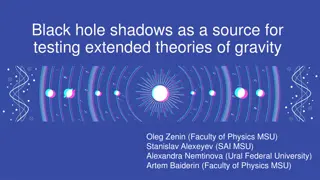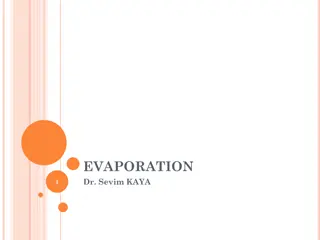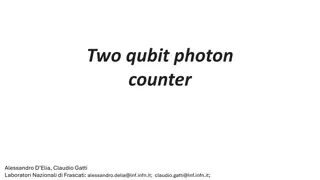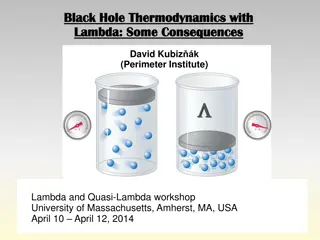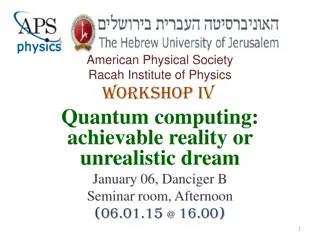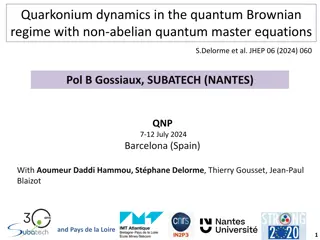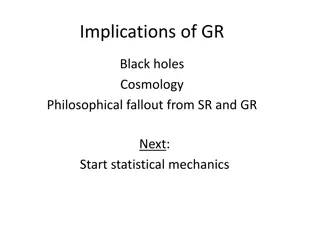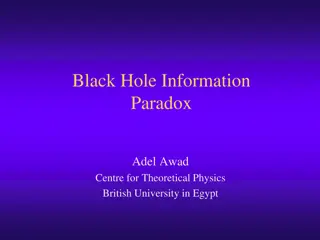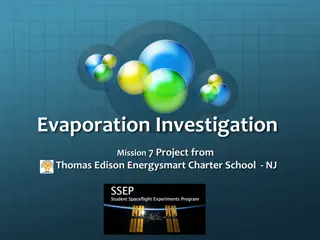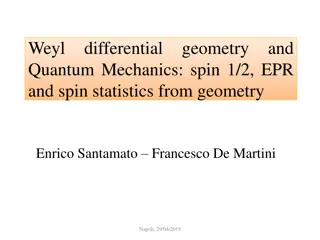Exploring Quantum Black Holes: Dual Dynamics and Brane Evaporation
Exploring the dual dynamics of quantum black holes reveals new perspectives on black hole evaporation. By placing black holes on branes, we can study their classical picture in higher dimensions. This approach provides insights that were previously unattainable, leading to a better understanding of black hole evaporation processes. The interaction between classical dynamics in an AdS bulk and gravity on the brane encodes the quantum dynamics of the dual CFT, shedding light on the intriguing connection between gravity and quantum field theory. The evaporation of brane black holes can be represented in various ways, highlighting the impact of large N CFT on the evaporation process and the instability of time-independent solutions.
Download Presentation

Please find below an Image/Link to download the presentation.
The content on the website is provided AS IS for your information and personal use only. It may not be sold, licensed, or shared on other websites without obtaining consent from the author. Download presentation by click this link. If you encounter any issues during the download, it is possible that the publisher has removed the file from their server.
E N D
Presentation Transcript
the dual dynamics of quantum black holes Marija Toma evi CPHT, Ecole polytechnique w/ Emparan, Luna, Suzuki and Way 2301.02587
history problem new method brane black hole evaporation results 2
history, motivation Tanaka 02 Emparan, Fabbri, Kaloper 02 Quantum dynamics in gravity is hard, and we still do not fully understand black hole evaporation We only have some perturbative idea about what s going on, and our understanding is best in models with low dimensions An idea emerged ~20 yrs ago when Tanaka and Emparan et al. thought about looking at the dual of the problem at hand In essence: put a black hole on a brane and look at its higher- dimensional, classical picture Such a classicalization of the problem gives a new perspective on the problem, letting us ask questions we could not ask before 3
history, motivation [de Haro, Skenderis, Solodukhin 00] In a bit more detail, classical dynamics in an AdSd+1 bulk with a d-dim brane holographically encodes the quantum dynamics of the dual d-dim CFT coupled to a d-dim gravity on the brane This means that we can view this setup from two perspectives: 1) either as an object in the bulk w/ some boundary conditions or 2) as a higher-curvature gravity coupled to a cutoff CFT on the brane 4
history, motivation So, how does that look like for brane black holes? A brane bh evaporating can be represented in several ways One can construct a droplet, or a funnel these are the principal representations The brane bh is coupled to a strongly-coupled, large N CFT BH evaporation would then simply mean sliding off the brane 5
history, motivation But bear in mind that we don t have the usual quantum fields la Birrell and Davies We have a large N CFT, so the evaporation time should be much shorter than for a few quantum fields The intuition is that we have many more channels into which the black hole can evaporate, and the rate is enhanced by large N This would suggest that we cannot find stable time-independent solutions of droplets and funnels: they would always evaporate quickly off the brane! 6
Fitzpatrick, Randall, Wiseman 06 Gregory, Ross, Zegers 08 Figueras, Lucietti, Wiseman 11 history, motivation The story turned out to be quite different though People did find stable droplets on Randall-Sundrum branes which were time- independent! How come an AF black hole surrounded by quantum fields does not evaporate? Where did we make a mistake? 7
Fitzpatrick, Randall, Wiseman 06 Gregory, Ross, Zegers 08 Figueras, Lucietti, Wiseman 11 history, motivation The answer lies in the second feature of brane CFTs: they are strongly-coupled Just as plasma balls emit only color-neutral glueballs , so does a black hole immersed in a strongly-coupled CFT But then, its Hawking radiation would have an energy of , and so would be invisible to the classical bulk geometry, which only encodes energies of -- we cannot see the brane bh evaporating! ? 1 ? ?2 In other words, if we have access only to confined dofs then we don t know how the bh evaporates 8
history, motivation In order to evaporate properly, the bh would need access to the deconfined degrees of freedom What is the bulk dual of this statement? The deconfined dofs ~ black hole in the bulk Access ~ the bulk bh must be connected to the brane bh This suggests that funnels and rattles should allow for evaporation! 9
history, motivation And what would be the driving mechanism behind this evaporation from the bulk point of view? We will need the horizons on the brane to pinch-off this is exactly the physics of the Gregory-Laflamme (GL) instability! Recall, the GL instability occurs for extended black objects, like black strings, leading to the creation of two or more separate black objects, like black holes 10
history, motivation Emparan et al. 13 So let us try to show the pinching/evaporation explicitly In order to do so, we would need dynamical evolution of the bulk configurations In general, this requires a difficult numerical procedure But we will resort to a different method: the large d effective theory 11
The large d method The large d limit effectively separates scales and isolates the dynamics of the horizon In other words, the spacetime away from the black hole is effectively flat the large number of dimensions suppresses the effect of the gravitational potential far from the black hole This suppression simplifies the equations and one can perform complicated dynamical simulations in a matter of seconds/minutes 12
The large d method One caveat we should keep in mind: The large d method can only study one type of black holes at a time This means that we first have to fix the brane black hole to be either large or small, and then we can study them In this talk, our examples will mostly constitute small AdS brane black holes, which are the natural ones for the analysis of evaporation 13
funnels Let us start with the funnel case first: We start with a solution for a black string in global AdS, whose metric can be written as ?2 ??2= cos2???2+??2?? ???? 1 We will analyze perturbations of the black string in gAdS, which correspond to different brane-CFT physics, that is, different radiation physics And we will look for such perturbations which could lead to the brane black holes sliding off 14
In pictures and videos Funnels Now that we have the funnel, we can perturb it to see when the black holes on branes will evaporate
In pictures and videos Funnels 1.0 The black holes evaporate on the brane, forming a bigger black hole in the bulk
In pictures and videos Funnels 2.0 One of the black holes evaporates, making the other one bigger
funnels Emparan, Licht, Suzuki, Toma evi , Way 21 These two examples show full evaporation on either one or both branes But this holographic setup allows us to have another interesting possibility Namely, if the funnel is thin enough, the evaporation can start as before, but the Gregory-Laflamme instability can kick in fast enough *in the bulk*, severing the connection between the brane bh and the rest In this case, the naked singularity that occurs in the bulk leads to some sort of disentangling between the brane bh and the CFT modes There is no known analogue of this phenomena for bhs w/ weakly-coupled matter 18
rattles Now let us try to evaporate rattles To obtain them, we can start with a funnel solution and perturb it in such a way so as to obtain twin droplets Then we perturb the droplets in various ways and try to find a perturbation that would lead to evaporation of the brane black holes Note first that we confirm that droplets which are only moderately perturbed do not lead to evaporation 19
In pictures and videos Rattles Small/moderate perturbations do not lead to an evaporating black hole on the brane! The situation is the same even if we have only one droplet
In pictures and videos Small rattles Small/moderate perturbations do not lead to an evaporating black hole on the brane! The situation is the same even if we have only one droplet
In pictures and videos Big rattles But big perturbations do!
questions How come small rattles don t lead to evaporation, but big ones do? Both allow the access to the deconfined dofs, so why is there this distinction? The answer lies in the second law of thermodynamics, that is heat flows from a hotter system to a colder one 23
back to thermo-basics Recall, large black holes in AdS have T = M, while small black holes behave as in AF space and T = 1/M If we start with a small droplet, it s hot, so it needs a colder system into which to evaporate A small rattle is a small black hole in the bulk hotter than the droplet! Need instead a bigger black hole in the bulk so that it s colder this way the droplet will want to flow its heat into it 24
With funnels colder colder hotter hotter r0< LAdS small AdS black hole hotter when smaller
The large d method: large brane bhs Let us just quickly show what happens with large brane black holes 26
summary, questions We can study the evaporation of brane black holes using the large d limit of General Relativity Evaporation on the brane is only possible when we have a colder black connection in the bulk either as a funnel or in the form of a big rattle Otherwise, the droplets become stable Can be best understood through the laws of thermodynamics heat will flow from a hotter system to a colder one But the more pressing question is how to understand all of these phases through the CFT lens 27
Thank you! 28




